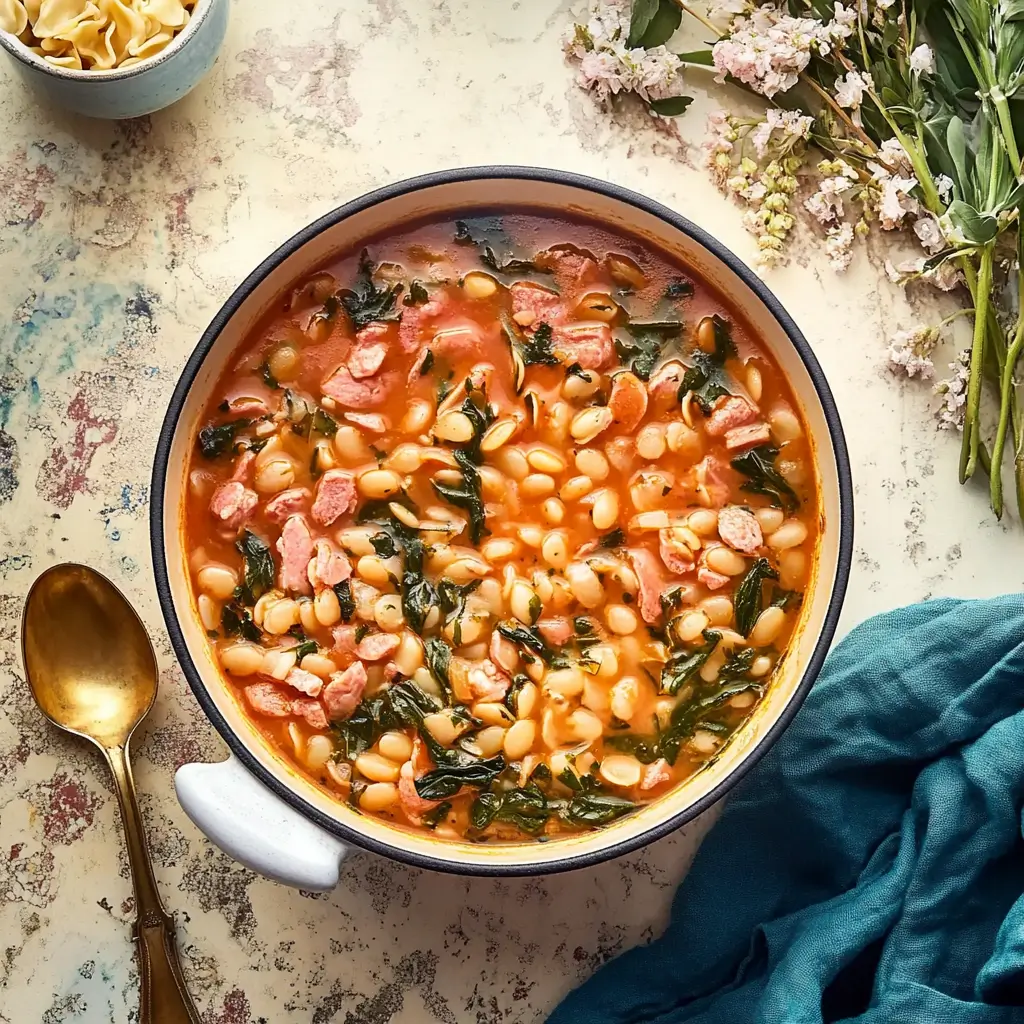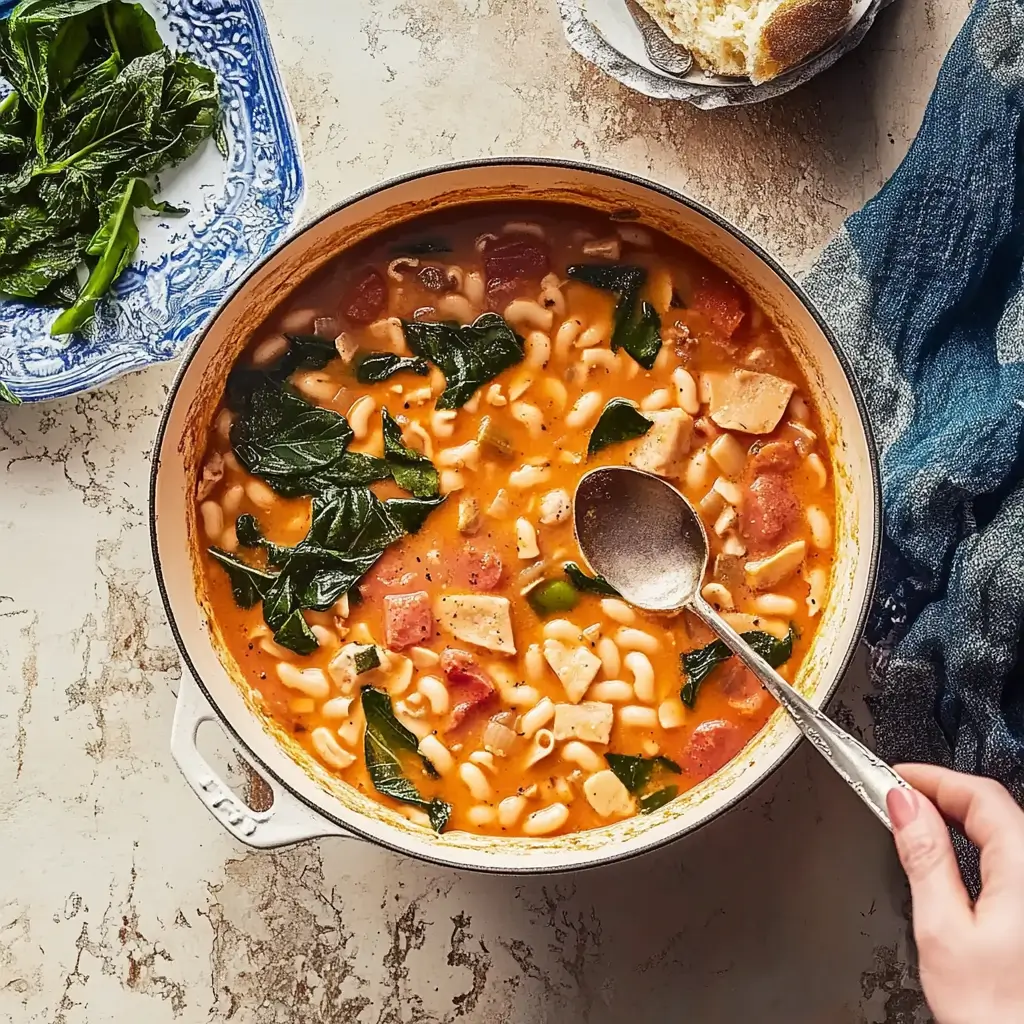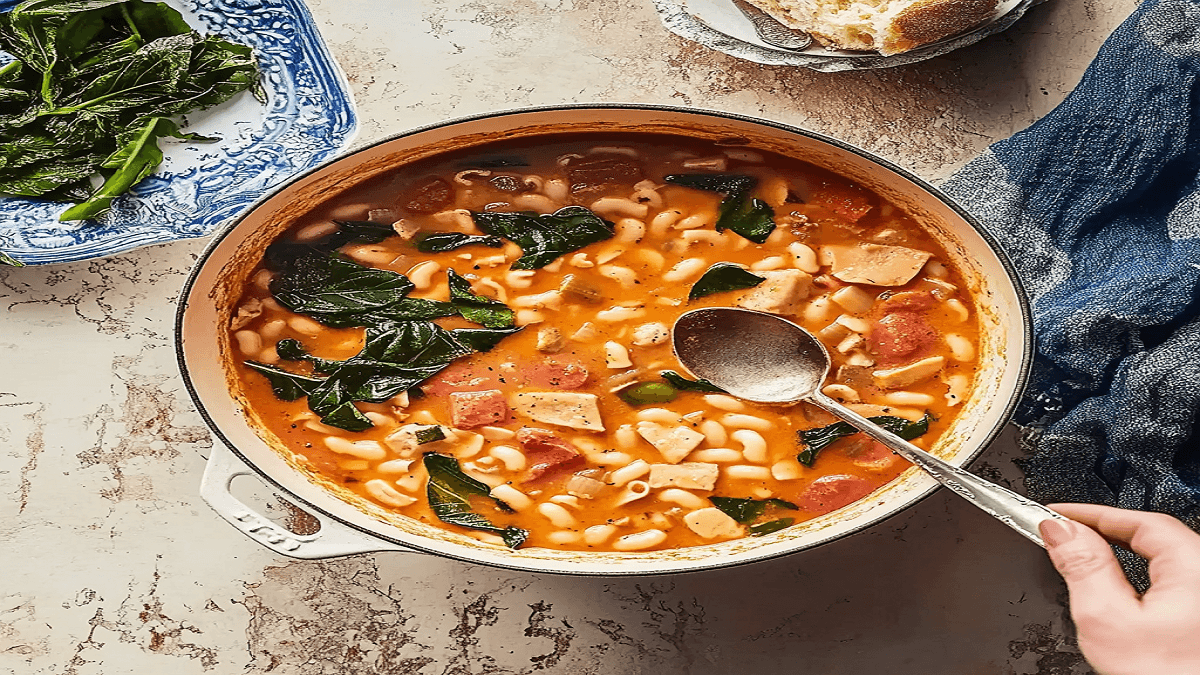Whether you’re wanting to impress your guests with a hearty, super-tasty, swamp soup and have it all, it’s inarguably to die for: thick and rich, loaded with all sorts of vegetables and meats to really occupy one’s mind with flavors and textures. It’s really a comfort for any occasion.
A swamp soup can be adapted to suit different tastes and dietary preferences, making it versatile for all kinds of palates. Whether you’re craving a spicy kick or a more subdued flavor profile, this soup has something for everyone.
Ingredients:
Now, let’s get to what you’ll need to make this swampy goodness. Don’t worry, it’s not too complicated, but it’s full of flavor. Here’s what you need to grab:
- 1 lb smoked sausage (Andouille sausage works wonders, but any smoked sausage will do)
- 1 lb chicken thighs (skinless, boneless – trust me, it’s juicy!)
- 1 cup celery (diced)
- 1 large onion (diced)
- 2 cloves garlic (minced)
- 1 cup green beans (fresh or frozen, whatever you’ve got on hand)
- 1 cup corn kernels (fresh, frozen, or canned)
- 1 cup okra (fresh or frozen – you can’t skip this one for that authentic swampy vibe)
- 4 cups chicken broth (or veggie broth if you’re going plant-based)
- 1 tsp thyme (dried or fresh)
- 1 tsp oregano
- 1 tsp smoked paprika
- 1/2 tsp cayenne pepper (optional, but it kicks things up a notch)
- Salt and pepper (to taste)
- 1 tbsp olive oil (for sautéing)

Instructions:
Step 1: Brown the Sausage & Chicken
Okay, first things first. In a large pot, heat up the olive oil over medium heat. Add your smoked sausage (cut into bite-sized pieces) and brown it up for about 5 minutes. This step gives your soup that deep, rich flavor. Once the sausage gets nice and crispy on the edges, take it out and set it aside. Then, toss in your chicken thighs (cut into bite-sized chunks) and brown them up too. This might take another 5–7 minutes. Pro tip: Season both the sausage and chicken with a pinch of salt and pepper as they cook—this helps build up flavor right from the start!
Step 2: Add the Veggies
Now we turn to vegetables. To that same pot, add your diced onions, celery, and garlic. Sauté for about 4-5 minutes until starting to soften and smell great. Your kitchen probably already smells great. Then toss in the green beans, corn, and okra. Toss everything together so you can get the veggies well mixed and starting to cook.Step 3: The Broth and Seasoning
Next, pour in your chicken broth and bring everything to a simmer. Stir in your thyme, oregano, smoked paprika, cayenne, and a bit of salt and pepper. At this point, your swamp soup’s starting to come together—don’t you love that feeling? You want to let this simmer on low for about 20 minutes. It gives the flavors a chance to marry, and those veggies really soften up.
Step 4: Bring the Sausage and Chicken Back
Add the browned sausage and chicken back into the pot and let it all simmer together for another 10 minutes. This gives everything a chance to mingle and soak up all that good stuff from the broth.
Step 5: Taste & Adjust
Such a stress buster is tasting the soup. Perhaps you could have added a touch extra salt, and pepper or even cayenne if you like. But do not shy away; after all, this is swamp soup. Or else, you may want to reduce broth further by leaving it uncovered for a minute or so.
So now lets have fun and taste the soup. Perhaps you want to add some extra salt, pepper or even cayenne, but don’t hold back: It’s your soup, have at it! Otherwise, you can always just reduce the broth a little more and leave it uncovered for a minute or two to allow it to thicken.
Step 6: Serve & Enjoy!
Once it’s perfect, ladle that swamp soup into bowls and dig in. It’s like a big ol’ bowl of comfort, and trust me, every spoonful is packed with flavor. You could sprinkle a little fresh parsley or even some grated cheese on top, but honestly, this soup stands on its own just fine.
Tips for a Quicker Meal:
- Use pre-cooked chicken: An already hurried::grab a rotisserie chicken, shred it-and get this: don’t brown regular raw chicken thighs. You’re gonna save yourself a little time.
- Frozen veggies work too: No need to worry about fresh okra or green beans—frozen ones work just as well!
- Make it ahead: This soup actually tastes better the next day after all the flavors have had a chance to sit together. Make a big pot, and you’ll have leftovers for days.
Why You’ll Love This Swamp Soup
To be honest, this soup is comfort food defined. Warm, filling, and that Southern flair that’s terrific for curling up on a chilly night. Plus, that wicked combo of tasty sausage, juicy chicken, and all those luscious veggies makes each and every last bite better than the last. Really, who can resist?
And let’s face it-some days you just need a soup to stick to their ribs, you know? Whether you’re feeding an army or want something hefty for yourself, this swamp soup is going to do the job just right!
Variations of the Swamp Soup
There are countless ways to personalize a swamp soup depending on what ingredients you have on hand or your personal preferences. Below are some popular variations:
- Vegetarian Swamp Soup: Removing the meat and adding more beans and some root vegetables such as sweet potatoes and carrots also adds rich flavors that come without the meat. They are quite earthy and rich with flavor.
- Spicy Swamp Soup: Kick it up a notch with the addition of jalapeños, cayenne, and even a drizzle of hot sauce. The punchy heat balances out the natural richness of the soup and brightens all those delicious depths of flavor.
- Seafood Swamp Soup: A coastal twist would be shrimp, crab, or fish instead of meats. The impact is a hint of freshness and slightly lighter texture.
- Slow Cooker Swamp Soup: For those who prefer a little less hands-on cooking, this is a slower cooker version of the swamp soup . Just toss ingredients in the morning and enjoy the magic of the slow cooker.
- Creamy Swamp Soup: For a richer, smoother soup, add a dollop of cream cheese or a splash of heavy cream toward the end of cooking. This gives the soup a velvety texture and a more indulgent taste.

FAQs About swamp soup
What is the secret ingredient in soup?
- The “secret ingredient” in soup can vary depending on the recipe and personal taste, but some common options that elevate the flavor include: Umami-rich ingredients like soy sauce, miso, or fish sauce
- Herbs like thyme, bay leaves, or fresh basil
- Acidic ingredients like lemon juice, vinegar, or tomatoes
- Stock or broth (instead of water) to deepen flavor
- A splash of wine or sherry can add depth
- A spoonful of butter or cream for richness
What is the most best soup in the world?
- This is subjective, as different cultures have iconic soups that are beloved worldwide. Some of the most renowned soups include:French Onion Soup
- Tom Yum (Thai hot and sour soup)
- Ramen (Japan)
- Minestrone (Italy)
- Pho (Vietnam)
- Chicken Soup (widely enjoyed globally, particularly for comfort)
- Each soup has its own unique qualities that make it stand out, so the “best” is often a matter of personal preference or cultural significance.
- Soups vary greatly by culture, with favorites like French Onion Soup .
How long can you freeze swamp soup?
- “Swamp soup” isn’t a standard term, but assuming it refers to a soup made with earthy or rich ingredients (e.g., a green, vegetable, or hearty stew), the general rule for freezing soups is:3 to 6 months is the ideal freezing time. Soups with cream, milk, or dairy may not freeze as well, as they can separate upon reheating.
- Be sure to cool the soup to room temperature before freezing, and store in airtight containers or freezer bags.
How to make creamy watery soup?
- If you’re aiming for a creamy yet light, watery texture, you can achieve this by:Using a clear broth (instead of heavy cream) as the base.
- Pureeing some of the soup (vegetables or legumes) to create a creamy consistency without the need for heavy cream.
- Adding a bit of butter or olive oil to give it a velvety finish without making it too thick.
- Balance flavors with a little bit of acid (like lemon or vinegar) to cut through the richness.
- Adding milk or a light cream instead of heavy cream can help achieve a creamy texture while keeping it light.
Why do chefs put vinegar in soup?
- Chefs add vinegar to soup for several reasons:Balancing flavors: Vinegar helps to cut through rich, fatty flavors, bringing balance to the dish.
- Enhancing acidity: A splash of vinegar adds brightness and can help bring out the natural flavors of the ingredients.
- Adding depth: A subtle tanginess can elevate the overall complexity of the soup.
- Preserving color and texture: In some vegetable soups, vinegar can help maintain vibrant colors (like in vegetable broths or with beets).
What are 4 other thickening agents for soup?
- There are several alternatives to traditional flour or cornstarch for thickening soups:Potatoes: Pureed potatoes or potato flakes can thicken a soup while adding a creamy texture.
- Rice: Blending cooked rice into the soup will create a creamy consistency.
- Lentils: Pureed cooked lentils (such as red lentils) can thicken a soup and add protein.
- Arrowroot or Tapioca Starch: These gluten-free starches are excellent alternatives to cornstarch and can be used to thicken soups without affecting the flavor much.
Related Recipes:
- How to Make Cannabis Cookies: A Step-by-Step Guide – If you’re in the mood for a sweet treat after your savory meal, these cannabis cookies might be a fun choice.
- How to Make a Perfect Peach Crumble Recipe (Easy & Delicious) – Looking for a dessert? Try this simple and delicious peach crumble.
- How to Make Crumbl Cookies at Home: Easy Recipe & Expert Tips – If you love cookies, here’s how you can make Crumbl-style cookies right at home.

